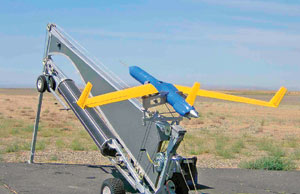What's new in exploration
SEG. Maybe it was the perfect weather, or the effect of $54 oil, but the annual SEG conference in Denver was surprisingly upbeat, given that there were only 6,500 attendees – typical for these shows in recent years. It would seem the days of 10,000-plus are behind us. Interesting commercial developments. At the SEG show, I ran into some commercial developments that were sufficiently noteworthy or just plain interesting. A sign of the times, not unlike what you've probably seen used on the battlefield – Fugro Airborne Services introduces unmanned aeromagnetic survey vehicles. Named the Georanger, it's a result of two years of R&D into Unmanned Airborne Vehicles (UAVs), in cooperation with Insitu Group, Inc., a developer of long-range unmanned aircraft for military and commercial applications.
The UAV is launched by the Superwedge launch system (see photo). It uses the same cesium vapor magnetometer technology that the full aircraft fly, only in a smaller package. Since there isn't an onboard crew, acquisition is inherently safer than conventional aircraft. It is truly autonomous, flying a preprogrammed flight plan at a cruising speed of 47 mph for up to 10 hrs. However, a ground crew can monitor its location, progress and status via the Iridium satellite network. At the end of its mission, it rendezvous at a predetermined location where a wire suspended from a crane or similar pole “lands” it. By snatching a hook at the end of one of its wings, the aircraft spirals down to a soft landing. The novel acquisition system should reduce costs for the contractor and its oil company clients alike. SGI and Landmark announced a new displayed dataset size record. The 400 GB dataset eclipsed the old record by 300 GB. It required SGI's Onyx4 visualization system running 64 processors, four graphics processing units and 512 GB of system memory. It was run on Landmark's Geoprobe software, and was displayed in association with Marathon Oil Co. The ability to display that much data allows enhanced views of regions, or smaller areas with great detail. Abiogenic methane. Or, here we go again. The headline read, “Untapped fossil-fuel reserves could be hidden deep within our planet.” The problem of non-biological origin of hydrocarbons is that the topic tends to become ideological – an all-or-none approach that bypasses science and open-mindedness, and often degrades into derision toward anyone who does not whole-heartedly embrace the dogma of the status quo. The reality is much more complex: molecules care nothing about human foibles; there are at least six ways that hydrocarbons can form, many of them not of biological origin. Henry Scott at Indiana University, South Bend, and his colleagues created methane in a laboratory. Further, they have shown that it is stable in the temperature and pressure environment found in earth's mantle, some 100 to 300 km deep. They put water, iron (II) oxide and calcite between two flat-diamond tips, applied 50,000 to 110,000 atmospheres of pressure, and heated the mixture to 1,500 °C. Scott commented, “Our results show that hydrocarbons can form from non-biological material and be stable, deep within the earth.” The mantle comprises 80% of the planet's volume, which implies that “much more carbon in the Earth could be in the form of hydrocarbons than we previously imagined.” The team's work will appear in Proceedings of the National Academy of Sciences this fall. A synopsis appeared in the Sept. 14 edition of Nature. In some ways, this comes as no surprise. It's been well known that methane vents from some volcanoes, and it's likely that at least some of the CO 2 vented is oxidized methane. The lab synthesis confirms a possible reaction for methane creation. The researchers plan to investigate whether oil can be formed under mantle conditions. Clearly, abiogenic hydrocarbon generation occurs in myriad ways, together with other hydrocarbon generation mechanisms, both biological, non-biological, and possibly, combinations of the two. There are a lot of questions that remain. What role, if any, would deep hydrocarbon genesis play in microbial subsurface life? Do these processes exist elsewhere in the solar system, explaining hydrocarbons on other planets, moons and in space? And finally, does this have any commercial significance? Does it explain a significant fraction of commercial accumulation in even one well? In a related matter, this December, assuming all goes well, the Cassini spacecraft, now in orbit around Saturn after a seven-year journey, will release the European Space Agency's Huygens probe. It might splashdown in a hydrocarbon ocean on the moon Titan in January. Keep posted. Mega merger, not. About two years ago, when PGS was in dire straights, CGG made the unusual move of buying an 8% share in its competitor. A year later, PGS declared Chapter 11 bankruptcy. This year, in September, buried at the bottom of its quarterly report, CGG announced an offer to acquire the PGS seismic business for $900 million, including $800 million in cash and $100 million in CGG shares. That offer was immediately rejected. CGG asked what was lacking, indicating it might be willing to increase its offering price. PGS' response was “far in excess of what can be reasonably expected to be bridged” and “exacerbated by the perception of recently improving seismic markets,” according to CGG. The offer was withdrawn in October.
|
|||||||||||





